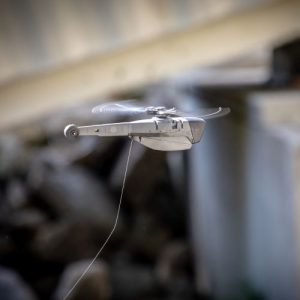
Polymer panels add camouflaging capability to defense drones
Canadian Plastics
Materials Research & DevelopmentResearchers from the University of South Australia have developed a range of lightweight panels capable of changing colour on demand to allow drones to match the colours of their environment.

Photo Credit: University of South Australia
Material scientists at the University of South Australia have worked with that nation’s Department of Defense to develop a range of lightweight panels that can change colour on demand, allowing drones to match their appearance to the background colors of the sky.
The problem they wanted to solve? Given the huge importance of remaining undetected during airborne intelligence, surveillance and reconnaissance (ISR) operations, the static colour of drones against the sky can be a significant hinderance against allowing them to fly undetected. In a nutshell, the sky changes colour, but the drones don’t.
But now, thanks to the newly developed polymer panels, the solution is at hand.
The polymers are what are known as electrochromic materials, which means they change colour in response to an electric field, and the exact colours can be tuned to specific voltages.
The newly developed panels have the ability to switch speeds in the range of seconds and offer colour memory, which means they retain their switched colour without a continuously applied voltage. They also operate in the range from -1.5 to +1.5 volts with the use of an AA battery to activate the change.
“Similar technology has been used in luxury cars, for diming mirrors, and on the windows of the Boeing 787 Dreamliner,” said Dr Kamil Zuber, lead researcher of the University of Australia’s Future Industries Institute. “But those applications are slow, require high power consumption to switch, and the electric flow must be maintained to sustain the change state.”
In addition to their chameleon-like characteristics, the panels are inexpensive, lightweight and durable, and can be either rigid or flexible, making them ideal for use on drones of all sizes and specifications.
“We have built a small-scale frame of a UAV [unmanned aerial vehicle] and put our panels on it,” Zuber said. “We have demonstrated it against all sorts of different sky states and completed a range of validation testing showing how these materials can respond in actual use. We have five or six different materials, and each of the materials can produce two to three distinct different colours.”
The technology is currently being refined to integrate self-awareness and autonomous adjustment into the system, so drones will be able to automatically change colour in response to changes in the surrounding environment.
At this stage, researchers are working mainly on the panels and the hardware, but during the latest stage of the project they have developed prototype electronics for the controller, which is something that could test the state of the sky and then automatically adjust the voltage to the panel to tune it to the right colour.
“So, if the UAV passed in front of a cloud, it would turn pale, then when it moved back into blue sky, it would turn back to blue,” Zuber said.
Source: University of South Australia
